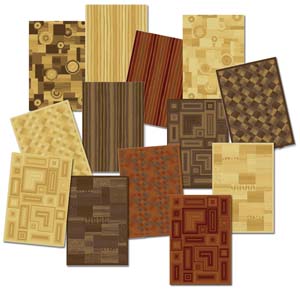 |
| Rug One Imports |
|
By Deena C. Bouknight
Columbia, S.C.—Fluctuating housing starts, rising materials costs, Chinese imports, and even high gas prices—all these impact the area rug industry. Despite challenges, however, the consensus among those supplying flooring, specialty retailer and home furnishings stores indicate area rugs remain a lucrative and profitable product category with high market share potential.
In fact, most in the rug industry believe 85% of consumers have at least one area rug in their homes.
“If someone gets a hardwood or tile floor, they are going to put an area rug on it,” said
James Beach, communications manager for The
Carpet & Rug Institute (CRI). Added Linda Harrington, the organization’s statistician, “Sales in area rugs have not decreased. This segment just seems to continue growing.”
Harrington said that official numbers for 2005 will be included in a full report by the end of 2006.
“Rugs are a continued area of growth for retailers,” said
Andy Martin, vice president of sales and marketing for
Rug One Imports, a 56-year-old company in New York and a division of Belgotex Industries. “Where the ever popular hard surface floor goes, so does a rug or runner with every installation.”
“Consumers pay a lot for hardwood, stone, travertine and slate flooring, for example, but then they realize quickly that, though beautiful, the floor is cold, noisy, hard and slippery,” said
Osby Borchardt, vice president of marketing for
Fabrica International, one of three brands owned by the
Dixie Group. “So they find a very nice rug.”
Borchardt said he has seen a growing demand at the high-end, where Fabrica is positioned. Its Odyssey program offers one-of-a-kind custom rugs made of nylon, with some wool. Working through a designer or a consultant at a retail specialty store, consumers choose just the right sizes, colors, styles, carvings, insets and edge treatments to coordinate with their specific decors.
Fabrica also offers a custom Traditions line of imported of 100% handtufted wool, and an Oriental Ziyada line of handknotted rugs.
“We’re selling to the upscale market,” said Borchardt. “We’re not a volume player. Our customer is someone who wants intricate and unusual in terms of sizes and design. More and more consumers at the high end want to go this route. And because of that, ours is a growing segment. So, we have a lot of competition. But we distinguish ourselves with quality craftsmanship and delivering exactly what the customer wants.”
Also strong is the lesser price point machine-made category. As the number of high-inventory retail locations carrying area rugs increases, so do sales of those products. Plus, better quality, colors and styles in machine-mades make them more appealing.
“I was in a home recently that was completely decorated in area rugs—even some on the walls. And many of them were machine-made,” said Martin. “Our quality, designs and colors are better than they’ve been in years. Consumers are buying machine wovens because the quality has improved, and they buy them for their warmth and aesthetic appeal. And then, when they are tired of that machine woven rug, they can replace it at a fraction of the cost.”
Rug One Imports’ new Panacea offers transitional and traditional designs of 100% Belgotex high performance heatset polypropylene rugs in six patterns and multiple colorways. A 5X8-ft. sells for $299. Groovy, brand new this summer, will meet demand for contemporary designs and sells for $249 for a 5X8-ft.
As
Jeff Meadows,
Shaw Living’s vice president also pointed out, there is a definite increase in mass merchant store openings. And, he reported, Shaw’s contemporary designs “have excelled over the past couple of years with the best selling price point being $199 to $299.”
“We projected growth this year, and so far we’re meeting those projections,” said
Ronnie Agrela, owner of
Rhody Rug. The braided area rug company is competing against Chinese imports by diversifying and offering, for example, two new polypropylene lines for indoor/outdoor use. Pointed out Agrela, there will always be that customer who desires the classic country traditional look in area rugs.
Even though the industry is affected somewhat by Chinese imports, Beach said he feels these imported goods represent too small of an amount to be a threat. And, though Meadows and others explained that rising raw materials costs over recent years remain a challenge, rug companies attempt to absorb many of those costs.
“We’re always looking at ways to cut our own costs,” said Martin.
Finally, those in the rug industry indicated retail business can remain strong if dealers commit to the category. Said Meadows, “Retailers who are in the rug business should make a commitment to the category so the consumer has no doubt the retailer carries area rugs and offers an assortment for all design needs.”
Added Borchardt, “Our patterns, designs and colors help us stand out in a retail setting, as do our merchandising aids, photography, and samples. It’s important that consumers be educated about the product.”
Still, as housing starts continue to increase and the square footage of homes climbs, the potential for area rug sales outweighs many of the obstacles ever-present for the industry.